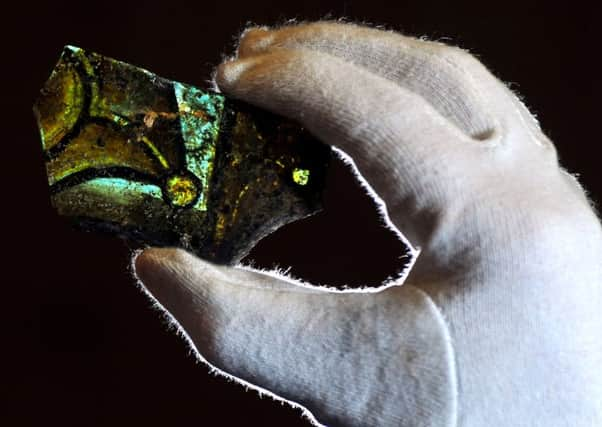Abbey’s precious artefacts tell a story


The exquisite items, including fragments of painted window glass, cast aside when the monastery was disbanded, have been conserved and are set to go on display in the new museum and visitor centre at the abbey, located in the Rye Valley close to Helmsley.
Ruins at Rievaulx are amongst the largest and most complex monastic remains anywhere in Britain and this week marked 477 years since the remaining monks surrendered their monastery to the royal commissioners.
Advertisement
Hide AdAdvertisement
Hide AdA spokeswoman for English Heritage said: “Among Rievaulx’s splendour is one of the finest monastic collections in the country.
“Featuring artefacts of international significance, many of exquisite beauty and craftsmanship, the collection tells the story of the site and its inhabitants from foundation to the present day.”
However at present there is only space to exhibit a small number of the items in the collection and a museum and visitor centre is being created to allow more items to go on display.
The museum will tell the story of the dissolution of Rievaulx Abbey through the artefacts left behind and discarded during the process to render the buildings useless and to extract as much value as possible from them. Fragments of painted window glass reveal glimpses of the beautiful windows which once adorned the abbey and were stripped out for sale or recycling following the dissolution.
While, a lead fother, weighing half a ton,
Advertisement
Hide AdAdvertisement
Hide AdA lead fother, or unit of lead, weighing half a ton and stamped with the King’s stamp, reveals how the lead was stripped from the roof and melted into monetary bars for the King’s coffers. However the fact the unit of lead was left behind shows not everything was recovered.
Susan Harrison, collectors curator at English Heritage said: “The third of December is a significant date in the history of Rievaulx Abbey. It was on this date over four hundred years ago that the monastery was effectively closed and the abbey ceased to be as busy and significant as it had been.
“Today, however, work on the new museum and visitor centre is going well and it’s this part of the abbey, through these historic items, where we’ll be able to tell the fascinating history of this significant Cistercian abbey.”
Rievaulx’s museum will be completely redesigned to create new and engaging displays that will explore the evolution of Rievaulx from founding to fall and beyond. Special objects, such as the near life-size Christ in Majesty statue, will form the core of the exhibition.
Advertisement
Hide AdAdvertisement
Hide AdBeautiful sculpture, coins, decorated floor tiles and painted window glass will go on display for the first time in new, specialist facilities for visitors.
The abbey has had a colourful history with the 1500s being a tumultuous time in England. The church was undergoing major changes with the reign of Henry VIII who broke with Rome when the Pope failed to annul his marriage to Catherine of Aragon.
In 1532 Henry declared himself supreme head, below God, of the Church in England and in the following years began to apply pressure to monastic institutions, such as Rievaulx. In December 1538, the then Abbot and remaining 21 monks gathered in the chapter house at Rievaulx and surrendered their monastery to the royal commissioners. They were cast out and received pensions.
Everything of value from the monastery was seized by the king and its new owner, the Earl of Rutland.